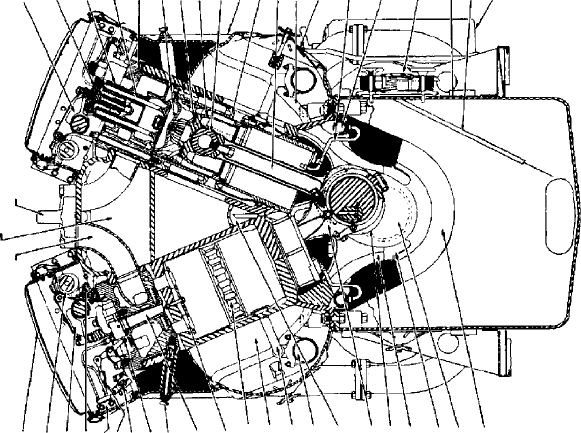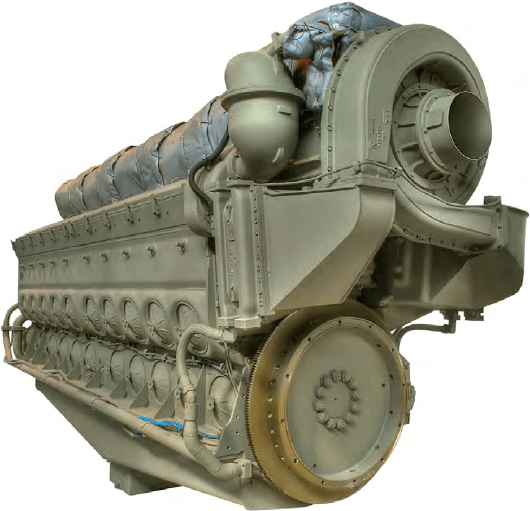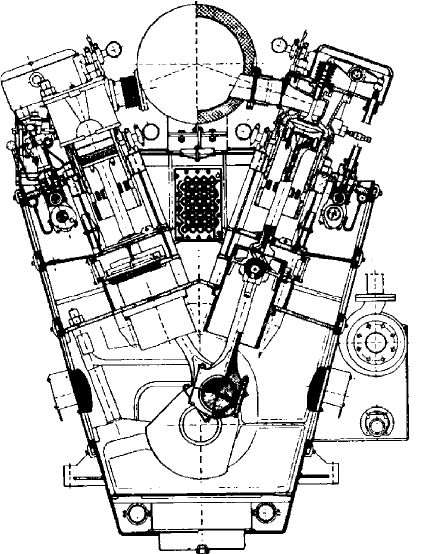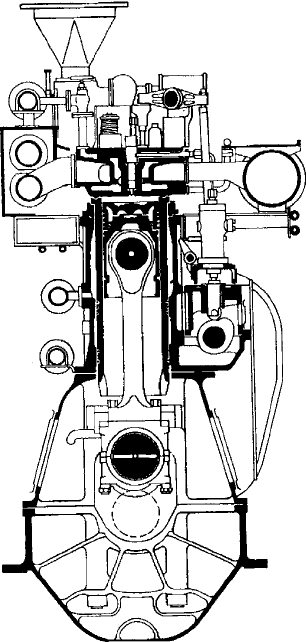Woodyard D. (ed.) Pounders Marine diesel engines and Gas Turbines
Подождите немного. Документ загружается.

Loyal to the two-stroke uniflow-scavenged principle for medium-speed
trunk piston engines—exploiting air inlet ports in the cylinder liner and exhaust
valves in the head—is the former General Motors’ Electro-Motive Division
(EMD), now the only exponent of the concept still serving the market. The US
designer argues better component wear life, reliability and serviceability over
four-stroke designs serving the same power range. Established in 1922, EMD
was fully incorporated into General Motors in 1941 and sold to a US-based
private equity partnership in 2005. The company claims to be the world’s larg-
est builder of diesel–electric locomotives, a rugged pedigree that has benefited
marine and offshore propulsion and genset engine sectors.
EMD
’s current 710G series covers an output band from 1249 kW to
3730 kW at 720/750/800/900 rev/min from V8-, 12-, 16- and 20-cylinder mod-
els. The 230.2 mm bore 279.4 mm stroke design (Figures 28.28 and 28.29)
was launched in 1986 as a longer stroke derivative of the established 645FB
range. A more advanced turbocharger (yielding a 10 per cent increase in the
overall air–fuel ratio) and larger fuel pump plunger diameter contributed to the
higher power rating and lower fuel consumption. Increasing the stroke raised
the cylinder displacement by 10 per cent from 645 in.
3
to 710 in.
3
(hence the
model nomenclature).
A number of improvements benefited the 710GB, GC and GC-T2 models
which offer outputs up to 187 kW/cylinder at 900 rev/min.
l An L-11 liner design for enhanced durability and performance, reduced
scuffing and higher wear resistance and better fuel economy.
l A Duracam camshaft, extending valve train component life and lower-
ing valve vibration.
l A Diamond 6-cylinder head with tangent flow fireface, yielding
improved cooling and better valve sealing, eliminating core plugs and
hence water leaks, and providing hardened valve guides for improved
valve and valve guide life.
l Improved unit fuel injector, with a new seal design, enhanced check
valve and stiffer follower spring.
l A four-pass aftercooler achieving improved thermal efficiency and
hence fuel economy, and exhaust emissions reduction.
l A new turbocharger incorporating an external clutch for easier
maintenance.
l Lower vibration levels from a new crankshaft and coupling disc-balanc-
ing technique.
With cylinders arranged in a V45° configuration, the two-stroke uniflow-
scavenged 710G design features overhead camshafts actuating the four exhaust
valves per cylinder and the unit fuel injectors. A unitized cylinder power
assembly with jacketed liner and minimal bolted and gasketed water connec-
tions simplifies maintenance and strengthens structural integrity.
A higher displacement than the 645FB series called for changes to the
crankcase, a larger diameter crankshaft, a new camshaft and larger diameter
two-stroke medium-speed engines 751

752 Other Medium-Speed Engines
plunger injectors. Longer piston rod assemblies and cylinder liners accommo-
dated the extended stroke, but overall the 710G engine was only fractionally
higher and longer than its predecessor. The 10 per cent increase in overall air–
fuel ratio was secured by the G turbocharger, significantly reducing thermal
loading on critical components. A unit fuel injector with a larger (14.29 mm)
plunger diameter than the 645FB engine (12.7 mm) delivered a higher injection
rate and shorter injection period. In addition, a spray tip incorporating seven
orifices yielded better combustion and higher thermal efficiency.
A piston crown design incorporating a toroidal-shaped combustion bowl
further fostered higher combustion efficiency when combined with the estab-
lished air swirl and well-atomized fuel spray. The larger cylinder displacement
Exhaust valve rocker arm
Exhaust valve bridge
Exhaust valve spring
Exhaust valve
Cylinder head
Piston
Thrust washer
Piston carrier
Piston pin
Crankcase
Cylinder liner
Blade connecting rod
Oil drain and vent
Air box handhole
cover
Piston cooling oil pipe
Piston cooling
oil manifold
Oil pan handhole cover
Oil pan
Oil level gauge
Strainer box
Lifting shackle base
Water discharge manifold
Exhaust elbow
Top deck cover
Camshaft
Injector rocker arm
Overspeed trip shaft
Fuel manifold
Injector adjusting link
Injector control shaft
Injector rack
Cylinder test valve
Fuel injector
Cylinder head crab bolt
Air inlet ports
Air box
Water inlet jumper
Water inlet manifold
Main lube oil manifold
Fork connecting rod
Connecting rod basket
Main bearing “A” frame
Main bearing cap
Crankshaft
Crankshaft counterweight
FigurE 28.28 general Motors EMD 710g two-stroke medium-speed engine with
overhead camshafts and unit injectors

enabled a 10 per cent larger combustion chamber, helping to minimize quench-
ing effects and promote lower emissions.
The capacity of the camshaft/valve train system was more than doubled
over the 645FB engine, allowing a reserve for future growth in injector size.
The camshaft base circle was increased from 2.5 in. to 3.25 in. diameter; the
cam roller follower diameter was increased by 0.375 in.; and the injector and
exhaust rocker arms were strengthened.
A larger and more efficient turbocharger achieved a 15 per cent increase in
air flow for reduced thermal loading. Transferring the over-running clutch from
the turbocharger housing to the engine gear train improved accessibility of the
clutch for inspection and replacement without disassembling the turbocharger.
An interesting feature of the 710G series is the single turbocharger with
externally mounted clutch which enables, in the lower load ranges, the turbo-
charger to be driven by the engine gear train in supercharger mode. Once the
engine load reaches around 65 per cent, the clutch disengages and allows the
exhaust gas to drive the turbocharger turbine. Full load can be accepted swiftly
and smoothly at any engine speed, says EMD, and a 10 per cent overload capa-
bility can be exploited for two out of every 24 h of running.
The electronically controlled engines are said to offer precise control and
facilitate tuning refinements, with full feedback of operating parameters to cus-
tomer control and monitoring systems. Continuing efforts to extend the period
between overhauls has resulted in a current recommendation of 30 000 h for
two-stroke medium-speed engines 753
FigurE 28.29 An EMD 710g two-stroke medium-speed engine in V20-cylinder form

754 Other Medium-Speed Engines
engines with an average duty cycle. Ease of inspection and maintenance is also
claimed, a unit power assembly being exchangeable in 4 h. Emissions perform-
ance of 710G-T2 engines is reflected in IMO, US EPA Tier II and EU Stage
IIIA certification.
Another medium-speed two-stroke design philosophy was pursued for many
years by Bolnes of The Netherlands until its acquisition by the Wärtsilä group
and the subsequent cessation of engine production. The company produced the
world’s smallest two-stroke crosshead engine, the last manifestation being the
190/600 series. The earlier 150/600 design is illustrated in Figure 28.30.
The 190 mm bore/350 mm stroke design delivered a maximum continu-
ous output of 140 kW/cylinder at 600 rev/min on a mean effective pressure of
14.1 bar. The range embraced 3–10 in-line models (excluding a four-cylinder
version) and V10–20 cylinder models covering an output band from 400 kW to
2800 kW. The crosshead took the form of a lower piston/scavenge pump, with
uniflow scavenging arranged via a single valve in the head. Air is drawn in by
the turbocharger, passes through a first-stage air cooler to the scavenge pump and
then fed to the cylinder for the compression stroke via a second-stage air cooler.
Bolnes cited the following merits of the design:
l Very low lubricating oil consumption due to the complete separation of
combustion space and crankcase.
FigurE 28.30 Cross-section through Bolnes VDnl 150/600 two-stroke engine
l Unique air control due to the design of the 260 mm bore crosshead scav-
enge pump which was claimed to secure completely smokeless combus-
tion under all load conditions.
l High performance at low speed (for example, 110 per cent torque at 70
per cent rev/min).
l Separate lubrication systems promoting good heavy fuel-burning
operation.
l Simple maintenance.
Bolnes engines had a faithful following in fishing, dredger, coaster and sur-
vey vessel propulsion sectors. The design was also valued as a test engine in
fuel and lubricating oil research laboratories.
gEnErAl ElECtriC
Four-stroke medium-speed trunk piston engines from US designer GE Marine
have found wider appeal in the international marine propulsion and genset
drive market in recent years, the current programme embracing V228 and L/
V250 designs. Both families have secured US EPA Tier II emissions compli-
ance certification.
gE V228 Series
A power range from 1044 kW to 3355 kW at 900–1050 rev/min is covered by
V8-, 12- and 16-cylinder versions of the 228.6 mm bore V228 (formerly 7FDM)
design. High-strength nodular cast iron is used to create a rigid monobloc
main frame with a V45° cylinder configuration and all water, fuel and exhaust
piping externally mounted to eliminate the potential for internal contamination.
Large access doors are provided to ease inspection and maintenance, while cas-
ing and ribbed cross-members dampen vibration.
Forged from high-quality steel and nitrided for long life, the one-piece
crankshaft features generous journals and crankpins to minimize surface loads;
large radii fillet-welded counterweights also reduce stress to foster a longer
lifetime. The tri-metal main bearings are oversized to reduce pressure while
providing an oil-wedge formation for low wear, and a sacrificial running-
in overlay promotes rapid conformity in start-up. Superior heat resistance is
sought from a nickel barrier, while a lead–tin overlay serves as a high-toler-
ance contaminant trap for particles and degraded oil.
Four-stud mounting of the unitized power assembly facilitates removal and
replacement of key components. Electron-beam welding of the steel cylinder
liner to the forged cylinder head prevents leakage, and stainless steel valve
seats, Inconel exhaust and chromed inlet valves and valve rotators are specified
to extend overhaul intervals and component lifetimes. High-strength composite
pistons incorporate forged steel crowns with oil splash cooling. A three-ring
arrangement distributing pressure more evenly and a cutback design contrib-
ute to lower lube oil consumption. The lightweight aluminium skirt offers
high heat resistance. The master and articulated rod share a common journal,
general Electric 755
756 Other Medium-Speed Engines
minimizing the engine length. Forged and hardened cams and journals on the
segmented camshaft foster reduced wear, and oversized end bearings decrease
loads for a longer camshaft life.
Precise fuel management and control are provided by GE’s electronic fuel
injection system, which helps to secure compliance with regulatory emissions
standards. GE group expertise in gas turbine technology was applied in design-
ing the turbocharger, a high compression ratio improving efficiency across
the load range. Dual modular pulse piping preserves exhaust pulse energy for
maximizing thermal efficiency, the dual pipe made of stainless steel for an
extended life.
A GE PowerStar controller houses the electronic governor unit, speed ref-
erence and load core, protecting the engine against overspeed, overload, low
oil and water pressures and positive crank pressure.
gE l/V250 Series
GE Transportation started developing its Evolution-series locomotive engines
in 1998, targeting a platform that would meet or exceed US EPA Tier II emis-
sions requirements without compromising fuel economy, reliability and dura-
bility. The resulting medium-speed design, well proven in locomotive duty,
was refined in 2006 and launched as the V250 series for marine applications.
Compact and high power-to-weight installations are promised from the
250 mm bore/320 mm stroke design, which is released in V12- and V16-cyl-
inder versions to cover an output range from 2732 kW to 4661 kW at speeds
from 900 rev/min to 1050 rev/min. An electronic fuel injection system based
on an electronically controlled unit pump serving a standard configuration side
entry injector fosters flexible operation in a range of applications as well as
optimized combustion at different engine speeds and loads.
GE’s PowerStar II controller drives the fuel injection system, exploiting
advanced closing point detection to secure better fuel economy and emissions
control. The system features improved diagnostics and display of all engine
parameters and faults without the need for a laptop computer. Engine protec-
tion algorithms can predict problems early to avoid damage.
Turbochargers based on GE’s established design were developed in part-
nership with GE Aviation to boost the V250 engines, all aerodynamic features
being upgraded to satisfy combustion and engine-efficiency requirements
(Figure 28.31).
A new articulated piston with three rings meets weight requirements and
exceeds peak firing pressure demands; the skirt and pin boss are supported by
the piston pin and are optimized to provide excellent lubrication and guidance.
A cylinder head with significantly increased safety factors is achieved with a
wall supported by the head gasket, a thicker flame deck, optimized placement,
larger exhaust seat ring cooling bores and smooth transition areas to avoid
stress concentrations.
The connecting rod benefited from considerable design changes addressing
reliability. Requirements for oil film thickness and pressure were met through

a combination of an increased bearing width and a smaller oil groove in the
bearing shell. The angle between the shank and big end split line maximizes
stiffness while allowing disassembly through the crankcase bore. Advanced
simulation tools developed by GE corporate R&D were used to verify the rod
design’s low-fretting risk.
High levels of reliability and durability were sought from the main bear-
ing, and the block, crankshaft and drive end were repackaged to offer suffi-
cient room for bearing size increases. The same hardening process used on the
established FDM/FDS engines was applied for improved crankshaft fatigue
strength.
Easier maintenance is addressed by a segmented camshaft, sectional
exhaust manifold, unitized power assembly and other features to simplify
component removal and replacement. The cylinder head, water jacket, cylin-
der liner, piston and connecting rod can be withdrawn from the engine as one
assembly by removing a small number of connections and fasteners. Both inlet
and exhaust manifolds are compactly arranged between the V-cylinder banks
to contribute to a narrow overall engine width.
The V250 marine engine shares most components with its locomotive par-
ent, such as connecting rods, power assemblies, cams, pistons, high-pressure
fuel equipment, main frame, exhaust system and crankcase. A number of ele-
ments, however, had to be developed or refined for marine applications: rigid
and isolation mounting systems; dual-impeller cooling water pump; mechanical
general Electric 757
FigurE 28.31 gE Marine’s V250 engine

758 Other Medium-Speed Engines
fuel transfer pumps; deep lube oil sump; class-certifiable integrated wire har-
ness; explosion-relief crankcase doors; heat shielding on the exhaust system;
flywheel and air starting system; and seamless steel shielded fuel lines.
GE L/V250 data
Bore, mm 250
Stroke, mm 320
Cylinders
6/8l/12/16V
Compression ratio 16.8
Speed, rev/min 900–1050
power range, kW 1498–4661
An in-line cylinder derivative of the V250 family was introduced in 2008,
the L250 engine offered in six- and eight-cylinder models with respective max-
imum ratings of 1922 kW and 2564 kW and continuous ratings from 1498 kW
to 2330 kW. While based on the V-design, the engine featured a number of
refinements and new components, including a main frame with optimized ribs
and an integrated air manifold, and a crankshaft with wide webs and tangent
fillets. The air and oil filters, fuel pumps, low- and high-temperature thermo-
static valves and sea water pump were also new to the in-line engine.
In addition, the L250 was designed with engine-mounted ancillaries for
ease of installation and maintenance, and an integrated power take-off system.
The GE-designed and manufactured turbocharger can be flexibly mounted at
either end of the engine, a facility (along with a narrower engine frame) that
eases retrofit projects.
759
C h a p t e r | t w e n t y n i n e
Low-Speed
Four-Stroke Trunk
Piston Engines
The marine diesel propulsion market is dominated by direct-coupled low-speed
two-stroke crosshead engines and geared high-/medium-speed four-stroke trunk
piston engines but some Japanese and East Asian regional operators of coastal/
short sea, fishing and small oceangoing vessels have long appreciated the mer-
its of a ‘hybrid’ alternative: the low-speed four-stroke trunk piston engine.
Low-speed four-stroke engine designs, a traditional Japanese speciality, are
characterized by simple and rugged construction and comparatively long strokes.
Nominal operating speeds, in some cases less than 200 rev/min, allow direct coup-
ling to the propeller. In contrast to the equivalent European/US engine sector,
served by high-/medium-speed machinery with a fixed bore size and variable
number of cylinders, the Japanese designs are invariably based on a six-cylinder in-
line configuration with a range of bore diameters to meet the desired power output.
As an example, Akasaka Diesels’ programme has over the years embraced
a dozen bore sizes from 220 mm to 510 mm, all offered in six-cylinder form
only. Other company ranges have extended up to 580 mm bore with outputs as
high as 735 kW per cylinder. Research and development efforts in the 1970s
addressed higher specific ratings, with some designers introducing two-stage
turbocharging systems to boost power. Enhanced operating economy, heavy
fuel-burning capability and reliability were pursued in the 1980s.
The drawbacks of the direct-coupled low-speed four-stroke engine concept
compared with medium-speed rivals are the fixed propeller speed (though some
models are arranged for reduction gearing), higher weight and increased space
demands. But these are outweighed, according to proponents, by advantages:
improved reliability and reduced maintenance derived from a fewer number of
components; less noise and vibration; better fuel and lubricating oil consump-
tion figures; and a greater ability to handle low-grade fuels.
With few exceptions, however, the Japanese designs have made little impact
in Western markets where the geared medium-speed engine maintains its

760 Low-Speed Four-Stroke Trunk Piston Engines
supremacy in the small-ship propulsion arena. This failure to break through
decisively reflects the difference in traditional vessel designs and operating
philosophies between the Asian and European/US sectors. And not all the
Japanese enginebuilders have made special export efforts to the latter territo-
ries, acknowledging that a substantial spares and service support network is
required for credibility. The doorstep markets of Indonesia, South Korea, the
Philippines and Taiwan offer the best export potential. The domestic market
represents the baseload for production, the enginebuilders enjoying longstand-
ing relationships with small- to medium-sized yards.
Hanshin Diesel is perhaps the most well-known designer/builder of the
hybrids outside Japan, the Dutch shipping company Spliethoff having stand-
ardized on its engines for deep sea cargo ships in the 1970s/1980s. The EL
design (illustrated in Figure 29.1), evolved by Hanshin since the late 1970s,
typifies the construction and performance characteristics of a contemporary
low-speed four-stroke design.
The EL programme was eventually reduced to 380 mm and 400 mm bore
models but past portfolios also included 300 mm, 320 mm, 350 mm and 440 mm
FigurE 29.1 Hanshin Diesel’s EL design
